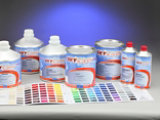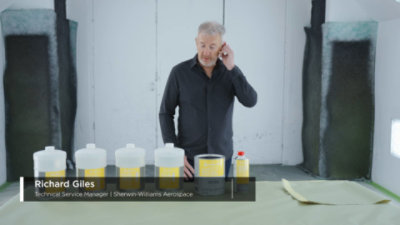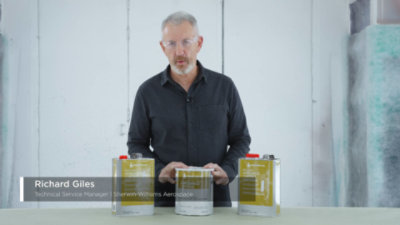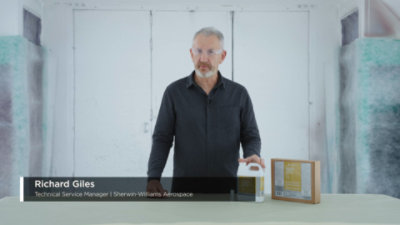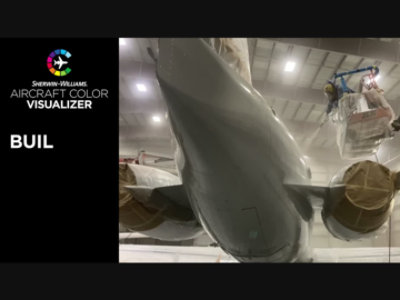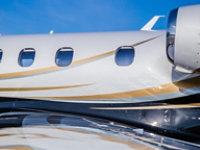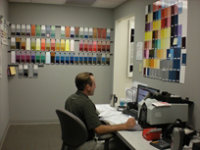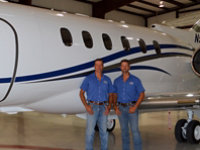WEBVTT
00:08.299 --> 00:09.467
In this tutorial,
00:09.467 --> 00:13.805
I'd like to talk about a new generation
topcoat up until this point.
00:13.805 --> 00:16.599
OEMs and MRO’s
00:16.599 --> 00:19.060
manufacturing and refinishing airplanes.
00:19.060 --> 00:23.857
Light airplanes,
GA commercial and rotorcraft.
00:23.857 --> 00:26.860
Of course, I've got two options.
00:26.985 --> 00:28.820
You have a single stage
and you have a base.
00:28.820 --> 00:29.946
Clear.
00:29.946 --> 00:32.907
Both systems valid? Depends what you want.
00:32.907 --> 00:33.867
What you wanting to do?
00:33.867 --> 00:35.326
Your expectations.
00:35.326 --> 00:38.204
Colors of course. Color space.
00:38.204 --> 00:42.125
We're very proud to launch
a new generation of topcoat called 858.
00:42.834 --> 00:45.837
This actually is a hybrid of both
of these systems.
00:47.172 --> 00:50.175
The first one is
this is solid color full glass.
00:50.633 --> 00:53.386
As it's a single stage,
00:53.386 --> 00:55.346
then it can be converted into a base
00:55.346 --> 00:58.349
coat, clear coat system.
00:59.142 --> 00:59.768
We all know
00:59.768 --> 01:02.771
that single stage
materials can be clear coated.
01:03.396 --> 01:04.606
The limitations are
01:05.690 --> 01:08.026
you have to apply the clear
01:08.026 --> 01:11.029
before drying a tape off
shortly afterwards,
01:11.196 --> 01:14.199
and it limits you to one particular color.
01:15.158 --> 01:18.411
With this eight foot 58,
if you decide, determine
01:19.287 --> 01:22.290
that you want to base
coat clear coat system,
01:23.041 --> 01:27.337
then you have a three day privilege
before you need to sun this material.
01:27.670 --> 01:29.672
The benefits of course.
01:29.672 --> 01:31.424
Let's take an example.
01:31.424 --> 01:32.926
You have a very plain Jane scheme.
01:32.926 --> 01:36.137
You have a white airplane
registration number, a couple of stripes.
01:36.846 --> 01:41.142
You should be able to install these over
the 858 with no sanding
01:41.726 --> 01:44.729
within three days of your process allows.
01:45.188 --> 01:47.774
What that gives you is,
01:47.774 --> 01:51.486
labor time of course, sanding
time, contamination, debris,
01:51.861 --> 01:54.948
luminance, all of that on a split base.
01:55.365 --> 01:58.076
You can also apply our,
01:58.076 --> 02:01.621
a fact line, which is the 850,
a flat line on top of this material.
02:01.996 --> 02:06.334
Of course, it will be repainted
with itself if it's another solid color
02:07.877 --> 02:11.047
supplied
from launch with three activators.
02:11.548 --> 02:13.216
And the kicker.
02:13.216 --> 02:16.177
If you look at the data sheet,
we spent a lot of time on this.
02:16.970 --> 02:20.348
We've given instruction
how you can blend the activators.
02:20.765 --> 02:23.560
So out of the three it's infinite.
02:23.560 --> 02:26.312
And the reason we do that
02:26.312 --> 02:29.315
is that we know depending on environment,
02:29.566 --> 02:32.569
the size of area, air flow
02:32.735 --> 02:35.196
that an activated may not fit.
02:35.196 --> 02:36.030
So what we do.
02:36.030 --> 02:38.366
We give instructions on how to blend.
02:38.366 --> 02:41.369
So you can make this very personalized.
02:41.744 --> 02:44.747
You can make it work for you.
02:45.373 --> 02:46.541
We also have a kicker.
02:46.541 --> 02:49.627
This is for small repairs
registration numbers etcetera etc..
02:50.295 --> 02:53.173
Very quick dry.
02:53.173 --> 02:56.176
And and useful for the very small areas
02:57.552 --> 03:00.555
on the clearcoat side,
you have three days.
03:02.015 --> 03:05.852
You can apply any aerospace
clearcoat on top of this material.
03:07.437 --> 03:09.814
We all know
that we finish this on their own blend.
03:09.814 --> 03:11.983
They can mix and match.
03:11.983 --> 03:13.484
They have their special primers.
03:13.484 --> 03:17.322
They have their special clear coats,
which they prefer and like so
03:17.322 --> 03:20.992
this may be over
coated with any clearcoat system.
03:22.118 --> 03:25.121
So let's look at the advantages of this.
03:27.373 --> 03:30.376
This performs
really well as a single stage.
03:31.628 --> 03:33.838
Good color fastness.
03:33.838 --> 03:38.468
Fluid gloss
retention, a great hang on rivets.
03:38.676 --> 03:39.969
Picture framing.
03:39.969 --> 03:42.347
Resisting picture framing.
03:42.347 --> 03:45.350
And it repairs while in service to.
03:46.517 --> 03:49.520
So it begs the question
on certain airplanes.
03:50.021 --> 03:52.398
Why would I clear this at all?
03:52.398 --> 03:55.777
Because you get such good performance
in a single stage.
03:56.861 --> 03:59.864
If we were applying this,
03:59.864 --> 04:01.824
split base where you have an effect
04:01.824 --> 04:04.827
barely, you could just clearcoat the
04:04.827 --> 04:08.289
the effect side of business or, again,
wrap the whole unit.
04:08.706 --> 04:12.126
So this three day privilege
is actually vital to the paint shop.
04:12.460 --> 04:17.882
With process changes you relabel
your enables you to continually
04:18.925 --> 04:21.469
mask off and apply this material,
04:21.469 --> 04:24.639
within not three days to compress time.
04:25.640 --> 04:28.643
For, just an efficient application.
04:29.185 --> 04:32.230
So the important thing equipment
do we have any
04:32.563 --> 04:35.525
limitations, any, certain,
04:36.359 --> 04:38.820
requests that you use on this material?
04:38.820 --> 04:40.196
Use whatever you have in the shop.
04:40.196 --> 04:43.783
This has been tested to conventional
air spray,
04:44.033 --> 04:47.036
HVRP compliant.
04:48.037 --> 04:50.832
We don't require you to change
any of your processes.
04:50.832 --> 04:52.458
No equipment.
04:52.458 --> 04:54.794
The fluid chips of the air caps. Just.
04:54.794 --> 04:56.587
Just run it as normal.
04:56.587 --> 04:59.590
Typically 2 to 3 coats,
depending on the color.
04:59.590 --> 05:00.717
Of course.
05:00.717 --> 05:06.306
What we do recommend, which is universally
known, is that with any,
05:06.306 --> 05:11.352
any topcoat system, you apply this over
a common ground coat system.
05:11.853 --> 05:15.148
For example, a gray a grayscale
05:15.481 --> 05:18.484
858 gray primer.
05:18.901 --> 05:21.988
You get color quicker, truer color,
05:22.488 --> 05:25.575
and you get better in-service
repairability.
05:26.200 --> 05:30.038
So make it the background
to this, single common color.
05:31.456 --> 05:32.957
So after all this being said,
05:32.957 --> 05:35.960
we're going to be mixing and I'm going
to be applying this in the paint shop.
05:36.419 --> 05:39.380
You'll see these have application
the fit and the finish.
05:39.380 --> 05:42.133
Great high to
05:42.133 --> 05:45.136
we're going to be using one
of these three activators in this case.
05:45.261 --> 05:48.264
And we're going to show you
the actual wet film and how it looks.
05:48.848 --> 05:51.559
So we'll show you in the paint shop.
05:51.559 --> 05:53.519
So we're in the paint shop.
This could be an aircraft.
05:53.519 --> 05:55.646
This could be a panel. Work like this.
05:55.646 --> 05:56.105
Like what?
05:56.105 --> 05:58.691
We what you see here could be components.
05:58.691 --> 05:59.442
The 858.
05:59.442 --> 06:03.654
In this case, that could be to code
with any any primer, of course.
06:03.654 --> 06:05.281
Surface.
06:05.281 --> 06:09.577
It could be a sanded, sand a coat doesn't
really make a difference in this case.
06:09.952 --> 06:12.705
It's one coat of primer
on these training foils.
06:12.705 --> 06:16.542
First thing we always do
is, for testing purposes,
06:16.918 --> 06:20.296
just put a, a on here,
and then we wash it down.
06:20.713 --> 06:22.757
We're using 110, 158.
06:22.757 --> 06:26.719
It's a wipe on, wipe off process,
although it's been clean and it's it's in
06:26.719 --> 06:28.179
the spray booth area.
06:28.179 --> 06:29.806
It's been drying overnight.
06:29.806 --> 06:33.768
So we always
we always wash down prior to application.
06:33.976 --> 06:37.021
So when we come to talking it,
sometimes it's misunderstood.
06:37.021 --> 06:38.940
This is treated like a scotch-brite.
06:38.940 --> 06:42.110
The tucking is a very, a very light,
06:43.236 --> 06:45.279
pressure on the surface
06:45.279 --> 06:49.242
and crosshatch up and down
side by side motions.
06:49.826 --> 06:52.578
And this picks up any,
any possible debris.
06:52.578 --> 06:56.165
What I generally do as
well is the adjacent paper,
06:56.249 --> 06:59.919
if you haven't changed it, of course,
if this is painted paper,
07:00.962 --> 07:03.256
give, give the whole thing attack.
07:03.256 --> 07:06.217
And again
you're eliminating the possibility of,
07:06.426 --> 07:09.429
reworking d nibbling Polish work.
07:10.930 --> 07:14.392
I'd rather spend the,
the five minutes on a good tuck
07:15.017 --> 07:17.478
rather than an hour on a spot repair.
07:17.478 --> 07:20.273
All sanding and de-nibbing.
07:20.273 --> 07:22.442
Get into the paper.
07:22.442 --> 07:25.403
So we're all cleaned.
07:25.403 --> 07:27.738
Okay, so now we're ready for paint.
07:27.738 --> 07:30.366
So we mix the 858, as you say,
three one, two.
07:30.366 --> 07:33.369
We've selected our activation,
which is the speed of dry.
07:34.454 --> 07:36.205
We're using in this case.
07:36.205 --> 07:40.001
And it's always good practice to filter
paint materials in.
07:40.001 --> 07:45.006
However these 125 micron pips
are quite good actually.
07:45.548 --> 07:48.551
Most of the cone filters are 190 microns,
07:48.718 --> 07:52.096
so these should actually capture
everything that you need.
07:52.638 --> 07:54.432
So it's a simple pour in.
08:04.317 --> 08:06.402
Compress.
08:06.402 --> 08:09.405
Now as far as the guns, today
08:09.655 --> 08:12.074
I'm using, a compliant gun.
08:12.074 --> 08:15.036
As you see here,
we've got the three, attachment.
08:15.286 --> 08:16.746
This one is digital.
08:16.746 --> 08:17.497
What does that mean?
08:17.497 --> 08:21.250
Well, rather than having engaged at
the base, it's actually within the handle.
08:21.250 --> 08:22.919
Very compact.
08:22.919 --> 08:25.922
So it's a simple clip on.
08:27.507 --> 08:28.299
Untwist.
08:28.299 --> 08:29.509
And there we have it.
08:29.509 --> 08:32.512
So that's our system.
08:32.595 --> 08:35.306
What I'll do is add
just the gun accordingly which is the
08:35.306 --> 08:36.933
the air pressure here.
08:36.933 --> 08:38.601
Fluid and density ratio.
08:38.601 --> 08:41.604
This is your fan compression
just to get the right wetness
08:42.146 --> 08:44.815
that we're looking for again on this
08:44.815 --> 08:47.818
or any, any wet material
08:48.027 --> 08:51.656
we supply wet
paint and wet paint is applied wet.
08:52.198 --> 08:55.201
So it would be better not to put a
08:55.576 --> 08:58.996
tac coat down
or an extremely light coat of paint down,
08:59.497 --> 09:03.251
because the second and third coat,
if there is three, they will.
09:03.251 --> 09:06.879
They will always follow the
the first layer.
09:07.213 --> 09:08.923
So the first layer will be wet.
09:08.923 --> 09:12.510
It will be a flow coat
but it will also be controlled.
09:12.885 --> 09:14.887
No runs, no socks.
09:14.887 --> 09:16.264
Perfect clothes from coat.
09:30.069 --> 09:34.115
To. Brown.
09:35.074 --> 09:38.077
So I have the first coat on our workpiece
plain.
09:38.911 --> 09:41.622
You can see these these,
09:41.622 --> 09:43.749
and black stickers and other cards.
09:43.749 --> 09:44.750
It's almost hiding.
09:44.750 --> 09:49.380
So it's telling me this is a two coat
color, assuming a common colored
09:49.380 --> 09:50.673
background.
09:50.673 --> 09:53.926
The primer underneath,
as you observed, is a neutral.
09:53.926 --> 09:56.554
So any any color covers it real well.
09:56.554 --> 09:57.763
So how did I do this?
09:57.763 --> 10:02.268
Well, as you can see, I'm using
a compliant gun the way I just did this.
10:02.268 --> 10:05.271
Look, the air
copy gives a PSI an optimum PSI.
10:05.271 --> 10:08.316
I always use the privilege of the cap
slightly over.
10:08.316 --> 10:10.109
You can certainly do that.
10:10.109 --> 10:13.696
This is running at 30 P.s.i engage
with compression.
10:14.947 --> 10:16.157
This is full fun.
10:16.157 --> 10:18.117
And this 1.3 needle in here.
10:18.117 --> 10:19.410
So full fun.
10:19.410 --> 10:22.330
Slight compression 30 psi
10:22.330 --> 10:27.043
one coat of paint one 5050 pass
as far as the flow in leveling
10:27.043 --> 10:30.588
you look at material is very thin
and in, actual thickness.
10:31.005 --> 10:34.008
But the profile is flat,
it's flowing out, it's flushing off.
10:34.508 --> 10:39.055
What we will do, with
this material is the traditional trick
10:39.472 --> 10:42.183
which is touching the material.
10:42.183 --> 10:45.061
If it doesn't transfer,
that's still not in flush.
10:45.061 --> 10:45.811
If it's sticky.
10:45.811 --> 10:47.772
But doesn't transfer the glove,
10:47.772 --> 10:51.484
that means you can apply
a second coat of material with the same
10:51.484 --> 10:55.446
batch of material with the same mix,
providing you're in the,
10:55.738 --> 10:58.741
the pot life of this material,
which is around four hours.
10:59.241 --> 11:00.910
So as you can see, the first coat is on.
11:00.910 --> 11:04.038
We've achieved flash, which is sticky,
but no transfer to the glove.
11:04.038 --> 11:05.456
So it's ready.
11:05.456 --> 11:08.668
The timer flush off will vary
between the activity, the chosen,
11:08.959 --> 11:12.380
the blend of activators,
or indeed the environmental conditions.
11:13.255 --> 11:16.592
So what we're going to do now
is, as you can see, we've got the DOI,
11:16.592 --> 11:17.385
we've got the glass.
11:17.385 --> 11:20.638
We need hiding is this indicates,
11:21.055 --> 11:23.724
two coats, color in this case.
11:23.724 --> 11:27.436
And we're going to apply the color
and, identical ways.
11:27.436 --> 11:28.104
The first coat,
11:29.271 --> 11:31.565
defeats, around three mils.
11:31.565 --> 11:32.983
Something of that nature.
11:32.983 --> 11:35.653
So here goes second coat.
11:35.653 --> 11:38.781
And then we'll review the,
we'll review the results.
11:51.085 --> 11:53.713
We now have a dry 858.
11:53.713 --> 11:54.463
It's been baked.
11:54.463 --> 11:57.466
In this case, we're spray bake.
11:57.466 --> 11:59.969
Alternatively, this will cold cure.
11:59.969 --> 12:01.554
So this material is now dry.
12:01.554 --> 12:03.347
As you can see, it's full gloss.
12:03.347 --> 12:04.390
Leave it as is.
12:04.390 --> 12:06.642
You do not need to base coat this.
12:06.642 --> 12:10.563
The privilege of this material
is that you now have three days
12:10.563 --> 12:14.024
to determine if you need to clear,
if you want to clear,
12:14.442 --> 12:17.611
or you can start the Liberty times
without the clear.
12:18.320 --> 12:21.323
So this hybrid system
12:21.615 --> 12:24.785
offers other possibilities of repaint.
12:25.745 --> 12:29.915
The split base with the clear leave the
majority of the aircraft in single stage.
12:30.791 --> 12:32.168
Clear this if you wish.
12:32.168 --> 12:34.211
If it needs to be a full base coat system.
12:35.504 --> 12:36.338
If it needs to be
12:36.338 --> 12:40.551
a full base coat system, and you're over
the three days, this will send indeed,
12:41.302 --> 12:44.305
like conventional single stage
or conventional clear coat,
12:44.722 --> 12:47.725
but eliminates a step.
12:48.434 --> 12:49.143
Happy painting.
